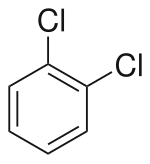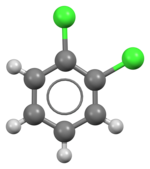This is the current revision of this page, as edited by Michael7604 (talk | contribs) at 21:29, 10 February 2024 (is an aryl chloride and). The present address (URL) is a permanent link to this version.
Revision as of 21:29, 10 February 2024 by Michael7604 (talk | contribs) (is an aryl chloride and)(diff) ← Previous revision | Latest revision (diff) | Newer revision → (diff) | |||
| |||
| Names | |||
|---|---|---|---|
| Preferred IUPAC name 1,2-Dichlorobenzene | |||
| Other names ortho-Dichlorobenzene, o-Dichlorobenzene, odcb, o-Dichlorobenzol | |||
| Identifiers | |||
| CAS Number | |||
| 3D model (JSmol) | |||
| ChEBI | |||
| ChEMBL | |||
| ChemSpider | |||
| ECHA InfoCard | 100.002.206 | ||
| EC Number |
| ||
| KEGG | |||
| PubChem CID | |||
| UNII | |||
| CompTox Dashboard (EPA) | |||
InChI
| |||
SMILES
| |||
| Properties | |||
| Chemical formula | C6H4Cl2 | ||
| Molar mass | 147.01 g/mol | ||
| Appearance | colourless liquid | ||
| Odor | Naphthalene-like | ||
| Density | 1.30 g/cm | ||
| Melting point | −17.03 °C (1.35 °F; 256.12 K) | ||
| Boiling point | 180.19 °C (356.34 °F; 453.34 K) | ||
| Solubility in water | 0.01% | ||
| Vapor pressure | 1 mmHg (20°C) | ||
| Magnetic susceptibility (χ) | -84.26·10 cm/mol | ||
| Refractive index (nD) | 1.54920 | ||
| Viscosity | 1.0656 (20 °C) | ||
| Hazards | |||
| Occupational safety and health (OHS/OSH): | |||
| Ingestion hazards | Mildly toxic | ||
| Inhalation hazards | Causes respiratory tract irritation | ||
| Eye hazards | Causes eye irritation | ||
| Skin hazards | Causes skin irritation | ||
| Flash point | 66 °C (151 °F; 339 K) | ||
| Explosive limits | 2.2%-9.2% | ||
| Lethal dose or concentration (LD, LC): | |||
| LD50 (median dose) | 500 mg/kg (oral, rat, rabbit) 200 mg/kg (oral, guinea pig) 436 mg/kg (oral, mouse) | ||
| LCLo (lowest published) | 1000 ppm (guinea pig, 20 hr) 800 ppm (guinea pig, 24 hr) 821 ppm (rat, 7 hr) | ||
| NIOSH (US health exposure limits): | |||
| PEL (Permissible) | C 50 ppm (300 mg/m) | ||
| REL (Recommended) | C 50 ppm (300 mg/m) | ||
| IDLH (Immediate danger) | 200 ppm | ||
| Safety data sheet (SDS) | External MSDS | ||
| Related compounds | |||
| Related compounds | 1,2-Difluorobenzene 1,2-Dibromobenzene | ||
| Except where otherwise noted, data are given for materials in their standard state (at 25 °C , 100 kPa).
| |||
1,2-Dichlorobenzene, or orthodichlorobenzene (ODCB), is an aryl chloride and isomer of dichlorobenzene with the formula C6H4Cl2. This colourless liquid is poorly soluble in water but miscible with most organic solvents. It is a derivative of benzene, consisting of two adjacent chlorine atoms.
It is mainly used as a precursor chemical in the synthesis of agrochemicals, as a preferred solvent for dissolving and working with fullerenes, as an insecticide, and in softening and removing carbon-based contamination on metal surfaces.
Production and uses
1,2-Dichlorobenzene is obtained as a side-product of the production of chlorobenzene:
- C
6H
5Cl + Cl
2 → C
6H
4Cl
2 + HCl
The reaction also affords the 1,4- and small amounts of the 1,3-isomer. The 1,4- isomer is preferred over the 1,2- isomer due to steric hindrance. The 1,3- isomer is uncommon because it is a meta- compound, while chlorine, like all halogens, is an ortho/para- director in terms of electrophilic aromatic substitution.
It is mainly used as a precursor to 1,2-dichloro-4-nitrobenzene, an intermediate in the synthesis of agrochemicals. In terms of niche applications, 1,2-dichlorobenzene is a versatile, high-boiling solvent. It is a preferred solvent for dissolving and working with fullerenes. It is an insecticide for termites and locust borers, historically used by the United States Forest Service to combat widespread bark beetle outbreaks.
1,2-Dichlorobenzene is also used in softening and removing carbon-based contamination on metal surfaces.
Safety
Data from human exposure to 1,2-dichlorobenzene shows that concentrations of 100 ppm have been reported to cause sporadic irritation of the eyes and respiratory tract. The Occupational Safety and Health Administration and the National Institute for Occupational Safety and Health have set occupational exposure limits at a ceiling of 50 ppm, over an eight-hour workday.
See also
- Chlorobenzenes—different numbers of chlorine substituents and isomeric forms
References
- Merck Index, 11th Edition, 3044
- ^ NIOSH Pocket Guide to Chemical Hazards. "#0189". National Institute for Occupational Safety and Health (NIOSH).
- Roháč, Vladislav; Růžička, Vlastimil; Růžička, Květoslav; Aim, Karel (September 1998). "Measurements of Saturated Vapor Pressure above the Liquid Phase for Isomeric Dichlorobenzenes and 1,2,4-Trichlorobenzene". Journal of Chemical & Engineering Data. 43 (5): 770–775. doi:10.1021/je9701442. ISSN 0021-9568.
- ^ "o-Dichlorobenzene". National Institute for Occupational Safety and Health (NIOSH). 4 December 2014. Retrieved 6 March 2015.
- Gerald Booth (2007). "Nitro Compounds, Aromatic" in Ullmann's Encyclopedia of Industrial Chemistry Wiley-VCH, Weinheim, 2005.
- "Battle of the Beetles". 25 July 2011. Archived from the original on 2021-12-21. Retrieved 22 April 2018 – via YouTube.
- Technical Order 2J-1-13
- "CDC - Immediately Dangerous to Life or Health Concentrations (IDLH): o-Dichlorobenzene - NIOSH Publications and Products". www.cdc.gov. 16 November 2017. Retrieved 22 April 2018.
- "CDC - NIOSH Pocket Guide to Chemical Hazards -o-Dichlorobenzene". www.cdc.gov. Retrieved 22 April 2018.

